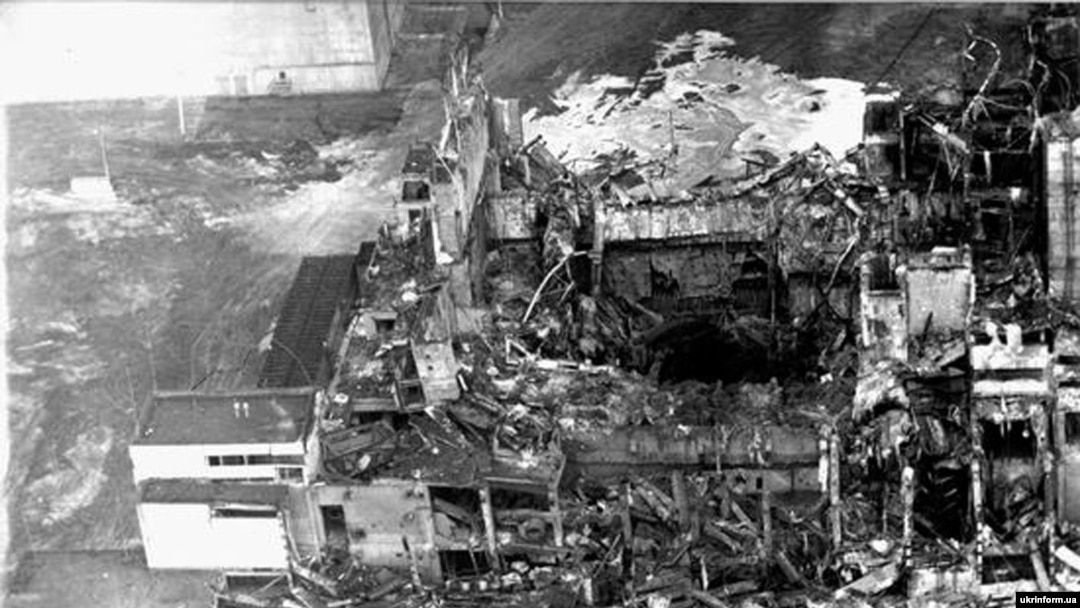At first, the Soviet authorities said nothing, and the first clear indication that something was wrong came when monitoring devices in Sweden began registering alarming increases in background radiation.
Deep unease quickly spread across Western Europe as people realized a huge cloud of radioactivity was drifting toward them.
Extent Of Disaster Slowly Revealed
In the Soviet Union and in Soviet-dominated Eastern Europe, people had still not been told of the danger.
Finally, on April 28, Soviet television carried a short announcement that gave no indication of the magnitude of the disaster: "There has been an accident at the Chornobyl nuclear power station. One of the atomic reactors has been damaged. Measures are being taken to eliminate the consequences of the accident. Assistance is being given to the injured and a government commission has been set up."
That simple message did not convey the drama going on at Chornobyl. U.S. satellite images showed that a reactor block at the nuclear power plant was blown apart and burned out.
Teams of men were fighting to stabilize the site, with each extra minute of exposure to the intense radiation sealing also their own fate.
It was not until two weeks later that Soviet leader Mikhail Gorbachev recognized the unprecedented scale of the accident. In a speech on May 14, he expressed sympathy for the victims.
"All of you know that we have been struck by a misfortune recently -- the accident at the Chornobyl nuclear power plant," Gorbachev said. "It has painfully affected the Soviet people and troubled the international community. We have, for the first time, confronted in reality the dreadful force of nuclear energy that got out of control."
Nuclear Energy Now Green?
The accident plunged the civil nuclear power industry around the world into crisis, as the public turned away from the possibility of more such environmental disasters. And so the matter might have rested, but for a new perceived danger: global warming, thought to be caused mainly by fossil-fuel use.
"It's hard to see how we're going to grapple with lowering carbon emissions without [nuclear energy] worldwide; nuclear energy is the main technology ready to be deployed on a much wider scale for generating electricity without carbon emissions," Hoare-Lacy says.
He notes there are 440 reactors now online in the world, with some 30 new plants under construction. And if nuclear energy is going to contribute meaningfully to carbon-emission reductions, then there could in future be a fourfold increase in this number of reactors. Modern reactor design, he says, removes the possibility of another catastrophe like Chornobyl.
...Or Still Environmental Threat?
Environmental activists disagree, and continue to regard nuclear power as fatally flawed.
"Nuclear power could be part of the solution to global warming, but it produces toxic waste that stays dangerously radioactive for tens of thousands of years, it's intimately associated with nuclear weapons, and can be very expensive; as a result we believe there are better solutions than nuclear power to the problem of global warming," says Roger Higman of the Friends of the Earth organization.
Higman lists all the alternatives, from solar and wind power to tidal power, to efficiency improvements and electricity-saving programs. However, many people are not convinced these "green" alternatives would be sufficient to power the heavily industrialized world.
He also points to the issue of nuclear weapons proliferation -- a potential problem when it comes to nuclear power.
"The technologies that are used -- enrichment technologies, reprocessing technologies -- can all be used to make materials for bombs, so there is an intense suspicion of countries like Iran, North Korea, when they develop their nuclear-power programs," Higman says.
"That's a big impediment to fighting global warming, because we have to be confident that any solution we use, we are happy for other countries, other parts of the world to use also, because global warming is an international problem," he adds.
Meanwhile, Chornobyl's seething mass of radioactive debris waits. The concrete sarcophagus built around the ruins of the shattered reactor in the months following the fire is rotting, weakened by intense radioactivity.
A U.S.-European consortium is building a new billion-dollar containment building, which should be ready by next year. But that won't be the end of the Chornobyl story by a long way.
| POINT-COUNTERPOINT | |
|
Industry 'Working Really Hard'
Thomas Tenfordee, president of the U.S.-based National Council on Radiation Protection and Measurements, says "they've done a good job of containing the problem." more
|
'Significance Downplayed'
Greenpeace nuclear-policy analyst Jim Ricco tells RFE/RL there are "a lot of cancers yet to come. more
|
Chornobyl 20 Years After
A CONTINUING CATASTROPHE: Twenty years ago in the early hours of April 26, a chain of events began in Soviet Ukraine that was to unleash a catastrophe of unprecedented scale. At 1:23 a.m., a massive surge of power in Reactor No. 4 at the Chornobyl nuclear power station caused an explosion that lifted the 1,000-ton lid off the reactor's core. Within hours, a column of radioactive material some 1 kilometer high was drifting northwest across Europe that would leave traces across the Northern Hemisphere.
In Belarus and Ukraine, the accident left huge swathes of land deserted and radioactive. An area of 30 kilometers around Chornobyl was evacuated and is still abandoned. Hundreds of thousands of people, many of them volunteers, fought courageously to contain the damage.
Twenty years later, what lessons have been learned from the disaster, and what is being done to address the damage it did to the region? In a series of articles, RFE/RL looks at these and other issues on the 20th anniversary of the Chornobyl nuclear disaster.
Read The Stories:
What Lessons Have Been Learned?
Liquidators Recall Disaster, Speak Of Life After
Photographers Aim To Keep Memory Of Disaster Alive
A Nuclear Nightmare Becomes A Political Disaster
Greenpeace, Others Challenge IAEA Report On Disaster Consequences
The Catastrophe's Political Fallout
LOCAL COVERAGE: Click here to see RFE/RL's coverage of Chornobyl in Russian, Ukrainian, or Belarusian.


